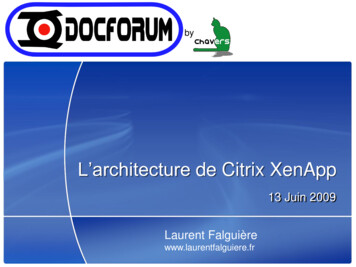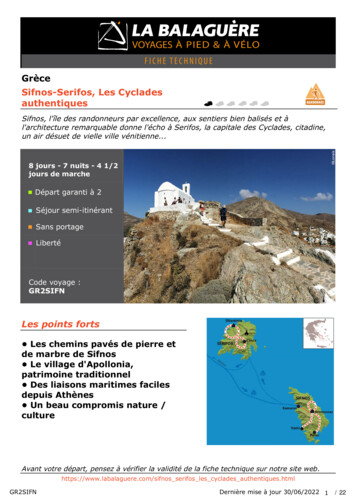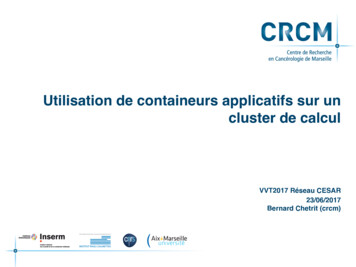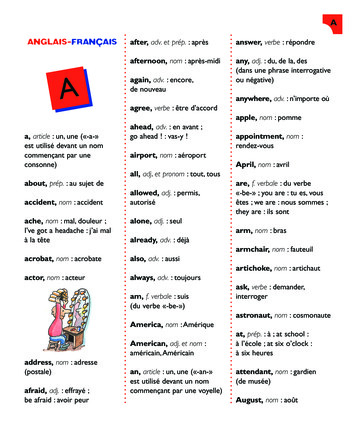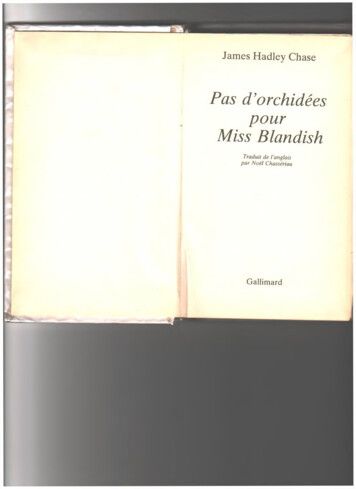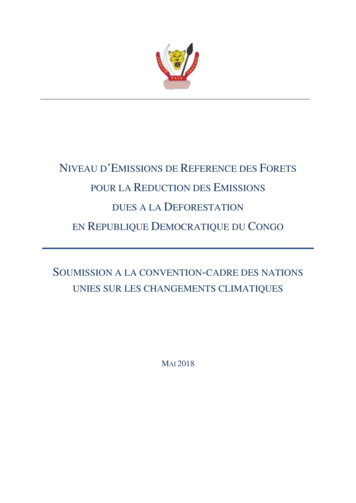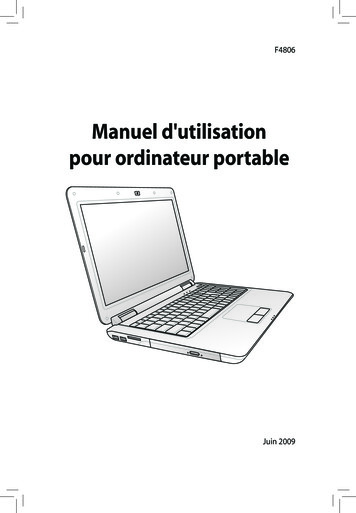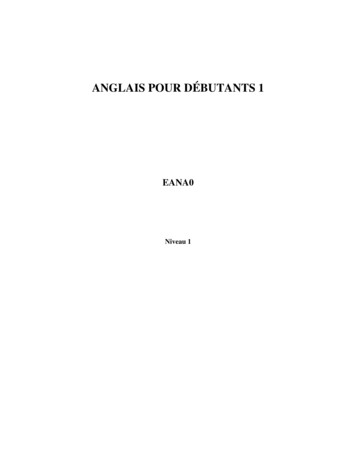
Transcription
ANGLAIS POUR DÉBUTANTS 1EANA0Niveau 1
Direction du projet:Coordination:Recherche documentaire :Rédaction:Consultation:Première relecture :Bernard LavalléeClaire TrépanierLauria RaymondBernadette LeMaySylvie BeaucheminPatrick LaplanteSonia Santor-SéguinSylvie LarivièreJeannine PrattSonia Sartor-SéguinCentre franco-ontarien de ressources pédagogiquesLe ministère de l’Éducation a fourni une aide financière pour la réalisation de ce projet mené à terme par le CFORP au nom des douzeconseils scolaires de langue française de l’Ontario. Cette publication n’engage que l’opinion de ses auteures et auteurs.Permission accordée au personnel enseignant des écoles de l’Ontario de reproduire ce document
TABLE OF CONTENTSCourse Profile Framework . . . . . . . . . . . . . . . . . . . . . . . . . . . . . . . . . . . . . . . . . . . . . .5Table of overall expectations and specific expectations . . . . . . . . . . . . . . . . . . . . . . .7Course Overview . . . . . . . . . . . . . . . . . . . . . . . . . . . . . . . . . . . . . . . . . . . . . . . . . . . . . .17Unit 1: Basic Oral Communications . . . . . . . . . . . . . . . . . . . . . . . . . . . . . . . . . . . . . .Activity 1.1: Introductions: Chain Names, Personal Profile and Getting Acquainted . . .Activity 1.2: English Sounds . . . . . . . . . . . . . . . . . . . . . . . . . . . . . . . . . . . . . . . . . . . . . .Activity 1.3: Interview, Physical Descriptions, and Mystery Persons . . . . . . . . . . . . . . .Activity 1.4: Basic Instructions and Directions . . . . . . . . . . . . . . . . . . . . . . . . . . . . . . . .Activity 1.5: Directions Lead Somewhere . . . . . . . . . . . . . . . . . . . . . . . . . . . . . . . . . . . .Activity 1.6: Social Encounters - Part I . . . . . . . . . . . . . . . . . . . . . . . . . . . . . . . . . . . . . .Activity 1.7: Social Encounters - Part II . . . . . . . . . . . . . . . . . . . . . . . . . . . . . . . . . . . . .Activity 1.8: Listen and Speak . . . . . . . . . . . . . . . . . . . . . . . . . . . . . . . . . . . . . . . . . . . . .Activity 1.9: Summative Assessment Task - “Getting Around” . . . . . . . . . . . . . . . . . . .21273138444855626878Unit 2: Strategic Reading . . . . . . . . . . . . . . . . . . . . . . . . . . . . . . . . . . . . . . . . . . . . . . .Activity 2.1: Reading Aloud: Feel for the Sounds . . . . . . . . . . . . . . . . . . . . . . . . . . . . . .Activity 2.2: Constructing Word Meaning Through Different Cues . . . . . . . . . . . . . . . .Activity 2.3: Word Associations: Increasing Vocabulary Range . . . . . . . . . . . . . . . . . . .Activity 2.4: Meaningful Reading: Making Connections . . . . . . . . . . . . . . . . . . . . . . . .Activity 2.5: Reading for a Variety of Purposes . . . . . . . . . . . . . . . . . . . . . . . . . . . . . . .858999104108113Unit 3: Speaking Up . . . . . . . . . . . . . . . . . . . . . . . . . . . . . . . . . . . . . . . . . . . . . . . . . . . .Activity 3.1: Using Functional English in Familiar Situations . . . . . . . . . . . . . . . . . . . .Activity 3.2: Conversations and Questions . . . . . . . . . . . . . . . . . . . . . . . . . . . . . . . . . . .Activity 3.3: Role Playing and Feedback . . . . . . . . . . . . . . . . . . . . . . . . . . . . . . . . . . . . .Activity 3.4: Improving Mechanics . . . . . . . . . . . . . . . . . . . . . . . . . . . . . . . . . . . . . . . . .Activity 3.5: Exploring a Theme . . . . . . . . . . . . . . . . . . . . . . . . . . . . . . . . . . . . . . . . . . .119124127133136140Unit 4: Writing: Sharing Opinions and Experiences . . . . . . . . . . . . . . . . . . . . . . . . .Activity 4.1: Response Journal: Recording Thoughts and Observations . . . . . . . . . . . . .Activity 4.2: Writing Experience Stories Collaboratively . . . . . . . . . . . . . . . . . . . . . . . .Activity 4.3: A Look at Some Writing Conventions . . . . . . . . . . . . . . . . . . . . . . . . . . . .Activity 4.4: Studying Modelled Forms: Letters and Personal Experience Stories . . . . .Activity 4.5: Strategies for Spelling . . . . . . . . . . . . . . . . . . . . . . . . . . . . . . . . . . . . . . . . .143148153156160165Unit 5: Developing Critical Thinking Skills . . . . . . . . . . . . . . . . . . . . . . . . . . . . . . . .Activity 5.1: Simple Idiomatic Expression . . . . . . . . . . . . . . . . . . . . . . . . . . . . . . . . . . .Activity 5.2: Basic Elements of Media Texts: Impact on Message . . . . . . . . . . . . . . . . .Activity 5.3: Learning about Anglophone Canadian Cultures in the Media . . . . . . . . . .Activity 5.4: Identify Values, Traditions, Attitudes of Canadian and American CulturesActivity 5.5: Influence of the English Language on Daily Activities . . . . . . . . . . . . . . .169174182187190193
4
COURSE PROFILE FRAME WORKCOURSE OVERVIEWUNITSACTIVITIESINFORMATIONSpace reserved for the school(to be completed)Description/RationaleUnit DescriptionDescriptionUnit TitlesStrands and ExpectationsStrands and ExpectationsUnit DescriptionsActivity TitlesPlanning NotesTeaching/Learning StrategiesPrior Knowledge RequiredPrior Knowledge RequiredAssessment/EvaluationTechniquesUnit Planning NotesActivity InstructionsResourcesCrosscurricular LinksAssessment/EvaluationTechniquesOSS Policy ApplicationsTeaching/Learning StrategiesResourcesCourse sAccommodations (forStudents with Special Needs)SecurityResources5
6
TABLE OF OVERALL EXPECTATIONS ANDSPECIFIC EXPECTATIONSUnitsANGLAIS POUR DÉBUTANTS 1Strand: Oral 24.45.35.4Overall ExpectationsEANAO-O-OE.1demonstrate an understanding of basic oralcommunications in English by providing oral responses inEnglish in different contexts;EANAO-O-OE.2use functional English in classroom and everydaysituations;EANAO-O-OE.3communicate their needs or seek information in English;EANAO-O-OE.4participate in discussions on familiar topics or situations;EANAO-O-OE.5demonstrate some understanding of the pronunciation andother mechanics of spoken 1.71.81.93.43.5Specific Expectations: ListeningEANAO-O-List.1acquire basic vocabulary and expressions by listening to avariety of oral ract information from a variety of live and recordedmaterial and make predictions about possible outcomes;1.8EANAO-O-List.3respond to oral statements and questions about familiartopics;1.41.51.9EANAO-O-List.4follow basic instructions and 14.25.35.5
UnitsANGLAIS POUR DÉBUTANTS 11Strand: Oral Communication23455.1EANAO-O-List.5demonstrate some awareness of simple North Americanidioms and their meanings;EANAO-O-List.6recognize sound patterns and simple sentence structures;1.21.9EANAO-O-List.7discriminate among blends, digraphs, and vowels;1.2EANAO-O-List.8demonstrate proper pronunciation after listening to storiesread or on tape;1.31.8EANAO-O-List.9demonstrate understanding of the role that mechanics playin conveying meaning in spoken language;1.61.7Specific Expectations: Speaking3.15.13.25.3EANAO-O-Sp.1use English to function in some everyday situations,integrating simple idiomatic expressions into theirconversations;EANAO-O-Sp.2respond to questions, give an opinion, and ask questions toclarify meaning;1.9EANAO-O-Sp.3recognize questions and construct acceptable responses inclass, using basic conversational conventions;1.61.9EANAO-O-Sp.4participate in group discussions on familiar topics;EANAO-O-Sp.5use correct articulation and pronunciation with familiarEnglish vocabulary;1.93.43.5EANAO-O-Sp.6use basic vocabulary acquired through various listening,reading, and writing activities in their own oralcommunications;1.93.3EANAO-O-Sp.7read aloud their written work, such as personal experiencestories, paying attention to content and the mechanics ofspoken language;2.32.45.35.45.55.14.14.24.4Specific Expectations: Communication SkillsEANAO-O-Comm.1select from a range of word choices and use simplesentence patterns to communicate ideas and information;EANAO-O-Comm.2use specific terms when participating in discussions andmaking oral presentations;EANAO-O-Comm.3use correct word order in simple declarative andinterrogative sentences;81.92.33.15.31.11.31.71.93.2
UnitsANGLAIS POUR DÉBUTANTS 11Strand: Oral CommunicationEANAO-O-Comm.4use simple connecting words to link ideas in speech;EANAO-O-Comm.5correctly use the three main verb tenses (present, past, andfuture);EANAO-O-Comm.6organize ideas and plan a short oral presentation dealingwith topics of personal interest;EANAO-O-Comm.7revise material before making an oral presentation andpractise articulating and pronouncing words andexpressions;EANAO-O-Comm.8adjust inflection to achieve the desired effect;EANAO-O-Comm.9use proper articulation, projection, and pitch in .55.35.51.11.2Specific Expectations: Media Communication SkillsEANAO-O-Media.1understand the main idea or message in selected ads,television shows, and other media works that depictelements of Canadian and American cultures;5.25.4EANAO-O-Media.2identify basic elements of media texts that enhance thecommunication of messages;5.2EANAO-O-Media.3use basic terminology when discussing visual elements ofprint and electronic media.5.29
UnitsANGLAIS POUR DÉBUTANTS 1Strand: ll ExpectationsEANAO-R-OE.1identify and read simple texts in print and electronicform;EANAO-R-OE.2read personal experience stories developed individuallyor in a group with confidence and comprehension;EANAO-R-OE.3use a variety of reading strategies to comprehend readingmaterial, and demonstrate their comprehension by statingthe main ideas in the material;2.22.32.42.5EANAO-R-OE.4explain their responses to various reading materials,integrating words and expressions from their readingsinto their vocabulary;2.12.22.32.5EANAO-R-OE.5read simple English aloud, pronouncing clearly andvarying intonation to create the desired effect.2.13.23.33.42.33.34.24.24.35.15.4Specific Expectations: Reading Comprehension1.3EANAO-R-Compr.1read various texts at an appropriate level of difficulty,demonstrating the ability to understand content;EANAO-R-Compr.2read personal experience stories developed by smallgroups or the whole group;EANAO-R-Compr.3follow the text of stories being read or on tape,demonstrating comprehension of new vocabulary andsimple written texts;EANAO-R-Compr.4follow simple written instructions;1.92.4EANAO-R-Compr.5answer simple comprehension questions;1.32.4EANAO-R-Compr.6gather information from reading material on a subject ofinterest to share with peers;2.5EANAO-R-Compr.7adopt different strategies and use knowledge of their firstlanguage to comprehend meaning;2.4EANAO-R-Compr.8use textual cues to construct and confirm meaning;2.3EANAO-R-Compr.9use syntactic, semantic, and graphemic cues to constructthe meaning of words in context;2.2EANAO-R-Compr.10use knowledge of word order in spoken English tounderstand written material;2.1EANAO-R-Compr.11locate the following parts of speech in context: nouns,pronouns, verbs, articles, and adjectives;105.25.35.44.22.25.14.3
UnitsANGLAIS POUR DÉBUTANTS 11Strand: ReadingEANAO-R-Compr.1223455.15.2interpret reading material in terms of personalexperiences;Specific Expectations: Vocabulary Acquisition and PronunciationEANAO-R-Voc.1recognize the Roman alphabet and its sounds;2.1EANAO-R-Voc.2use knowledge of commonalities in word families toincrease vocabulary in a variety of contexts;2.3EANAO-R-Voc.3develop a bank of sight words from personal experiencestories;EANAO-R-Voc.4use familiar vocabulary and context to determine themeaning of new words;2.2EANAO-R-Voc.5explore a variety of sources to acquire new vocabulary;2.3EANAO-R-Voc.6use patterns of word structure to determinepronunciation;2.1EANAO-R-Voc.7identify and pronounce sounds particular to English;2.1EANAO-R-Voc.8participate regularly in choral and small group readings;2.1EANAO-R-Voc.9read aloud, demonstrating proper articulation, intonation,projection, and pronunciation;4.25.13.33.4Specific Expectations: Critical Thinking and ResponseEANAO-R-Crit.1identify the main ideas in simple literary andinformational texts;2.4EANAO-R-Crit.2identify details and sequences to understand, and discussthe meaning of, stories;2.4EANAO-R-Crit.3make connections between texts, prior knowledge, andpersonal experiences;2.43.3EANAO-R-Crit.4demonstrate the ability to comprehend a wide range ofwritten material at the appropriate level of difficulty for awide range of purposes;2.53.2EANAO-R-Crit.5articulate their opinions by identifying and comparingideas from a variety of written material.114.15.45.25.3
UnitsANGLAIS POUR DÉBUTANTS 1Strand: Writing123452.12.22.33.54.14.24.45.15.3Overall ExpectationsEANAO-W-OE.1use English vocabulary acquired in real and familiarcontexts and through classroom activities for writtenexpression;1.21.31.41.7EANAO-W-OE.2write simple declarative and interrogative sentences, makingcorrect use of statements and questions;1.11.41.6EANAO-W-OE.3describe personal experiences in stories, using shortsentences and paragraphs and focusing on content andpresentation of material;EANAO-W-OE.4correctly use the conventions of the English languagespecified for this level;EANAO-W-OE.5apply computer skills to enhance and produce final drafts ofpersonal experience stories.4.24.41.62.44.24.34.44.54.4Specific Expectations: Forms and Techniques4.1EANAO-W-For.1record events, observations, feelings, and opinions in aresponse journal;EANAO-W-For.2write personal experience stories in collaboration withothers and read them to the group;EANAO-W-For.3write personal experience stories individually;EANAO-W-For.4write various forms of texts based on models provided;1.31.6EANAO-W-For.5write simple sentences;1.1EANAO-W-For.6use declarative and interrogative sentences in the affirmativeand negative forms;4.1EANAO-W-For.7develop paragraph skills;4.1EANAO-W-For.8arrange ideas and information in a logical sequence;EANAO-W-For.9revise and proofread written material using a variety ofresources;4.24.4EANAO-W-For.10use vocabulary (bank of sight words) acquired from thecollaborative writing of personal experience stories andfrom reading 2.43.54.24.45.3
UnitsANGLAIS POUR DÉBUTANTS 11Strand: Writing234Specific Expectations: Use of ConventionsEANAO-W-Use.1correctly use periods and question marks as endpunctuation;4.2EANAO-W-Use.2apply conventions of basic capitalization and punctuation;4.2EANAO-W-Use.3recognize and use consonants (hard and soft) and consonantblends:– hard, soft c and g– y as a consonant– silent letters– consonant blends– consonant digraphs;1.22.1EANAO-W-Use.4identify and use vowels:– long and short– y as a vowel– r-controlled vowels (ar, er, ir, or, ur)– vowel digraphs;1.22.1EANAO-W-Use.5demonstrate knowledge of the following parts of speech:common and proper nouns, personal and interrogativepronouns, articles, adjectives, and verbs;EANAO-W-Use.6recognize the grammatical function of nouns and pronounsas subjects;4.3EANAO-W-Use.7use proper noun-pronoun agreement (person, number, andgender) and subject-verb agreement;4.3EANAO-W-Use.8correctly use the following verb tenses in the indicativemode: present, past, and future for the most common regularverbs and the irregular verbs to be and to have;4.24.42.24.3Specific Expectations: SpellingEANAO-W-Spel.1spell familiar words, using a variety of strategies andresources;4.5EANAO-W-Spel.2correctly spell words identified by the teacher;4.5EANAO-W-Spel.3predict the spelling of unfamiliar words, using variousstrategies;4.5EANAO-W-Spel.4confirm the spelling of unfamiliar words, using variousresources (dictionaries, personal spelling lists);4.44.5135
UnitsANGLAIS POUR DÉBUTANTS 11Strand: Writing2345Specific Expectations: Visual PresentationEANAO-W-Pres.1choose the format that is appropriate for the purpose ofwriting;4.2EANAO-W-Pres.2accurately use a variety of organizers when writing aresearch report or preparing a special presentation;4.24.4EANAO-W-Pres.3use underlining and colour and vary size of print foremphasis;4.2EANAO-W-Pres.4select visual material to complement a written assignment ona topic of personal interest.4.2145.1
UnitsANGLAIS POUR DÉBUTANTS 1Strand: Social Skills and Cultural 5.5Overall ExpectationsEANAO-S-OE.1demonstrate adaptation to their new environment;EANAO-S-OE.2demonstrate some knowledge and appreciation of anglophonecultures in Canada.Specific Expectations: Social SkillsEANAO-S-Soc.1use English in a variety of daily-life situations;EANAO-S-Soc.2identify some services available in the community;EANAO-S-Soc.3identify the status of English in Franco-Ontarian schools andtheir new environment;EANAO-S-Soc.4demonstrate an awareness of classroom routines, teacherexpectations, and common courtesies of group work;EANAO-S-Soc.5select and use socially appropriate language andconversational gambits;3.15.54.23.14.24.4Specific Expectations: Cultural AwarenessEANAO-S-Cult.1demonstrate respect for anglophone cultures and Englishlanguage literature;5.3EANAO-S-Cult.2demonstrate an understanding of and respect for culturaldifferences in oral expression;5.4EANAO-S-Cult.3provide basic information about contemporary anglophoneCanadian cultures;EANAO-S-Cult.4communicate information through individual presentationsabout the influence of the English language on their ownlives;EANAO-S-Cult.5identify similarities and differences between anglophoneCanadian and other anglophone cultures as portrayed in themedia.153.54.15.34.24.45.55.4
16
COURSE OVERVIEW (EANAO)Espace réservé à l’école (à remplir)School:School District:Department:Department Head:Course Developer(s):Development Date:Course Revisor(s):Revision Date:Course Title: Anglais pour débutantsGrade:Course Type: OpenSchool Course Code:Secondary Policy Document: Anglais pour débutantsPublication Date: 1999Ministry course Code: EANAOCredit Value: 1Description/RationaleAPD 1 is designed to meet the needs of students who have very little or no knowledge of theEnglish language. This course initiates the non-English-speaking student into the Englishlanguage and a new cultural environment. The course focuses on four communication skills:listening, speaking, reading, and writing. Students will acquire basic communication skills and abasic vocabulary, read simple texts, and develop the ability to use simple sentence and paragraphstructures in response journals and personal experience stories. Activities include discussions,presentations, group and individual work, and sharing stories about personal experiences.Unit TitlesUnit 1:Unit 2:Unit 3:Unit 4:Unit 5:Basic Oral CommunicationsStrategic ReadingSpeaking UpWriting: Sharing Opinions and ExperiencesDeveloping Critical Thinking Skills17Time:Time:Time:Time:Time:20 hours25 hours20 hours25 hours20 hours
Unit DescriptionsUnit 1: Basic Oral CommunicationsIn this unit, students will focus on two important skills: listening and speaking. Students learnbasic vocabulary and simple sentence structures in a variety of activities: drills, dialogue, roleplaying, group discussion. Listening and speaking activities offer students the opportunity todevelop their comprehension and oral expression. The selections on tape will be short andsimple. The vocabulary, instructions, conversational conventions, simple interrogative anddeclarative sentences, and simple connecting words are adapted to meet the needs of students atthe basic level.Unit 2: Strategic ReadingIn this unit, students will use a variety of cues to facilitate their comprehension of readingmaterial. They will develop the ability to state the main ideas of simple literary and informationaltexts, make connections between texts and prior knowledge, and integrate words and expressionsfrom their readings into their vocabulary. Students will share their impressions and reactions toreading material, answer questions orally, and review familiar vocabulary.Unit 3: Speaking UpIn this unit, students will develop their ability to speak with some confidence in the classroomsetting and daily-life situations. If students are to experience a feeling of success in talking aboutsome everyday situations, then they need to express in English the things they say in their owntongue. They will use specific terms in discussions, presentations, and in everyday situations.Students are encouraged to use proper pronunciation, articulation, and intonation. They will learnsimple idiomatic expressions and use socially appropriate language and conversational gambits.Unit 4: Writing: Sharing Opinions and ExperiencesIn this unit, students will have the opportunity to express themselves in writing. Writing at thislevel is controlled and teacher-guided. Students will express personal opinions in responsejournals and write various forms of texts (e.g., letters, personal experience stories) based onmodels provided. They will use vocabulary acquired through classroom activities and readingassignments of previous units. The model compositions and lessons are planned in such a way asto help students gain some awareness of mechanics (how to spell, punctuate, and use somegrammatical conventions) and some degree of competency (what to say, how to organize it, andhow to say it) in their writing.Unit 5: Developing Critical Thinking SkillsIn this unit, students will use the skills and knowledge acquired through the first four units withrespect to listening, speaking, reading, and writing. They will respond to classroom discussions,selected media works, and reading material in terms of personal experiences. Students willbecome more familiar with their cultural environment and begin to appreciate the impact of themedia on their lives.18
Teaching/Learning StrategiesIn this course, the teacher selects various teaching and learning strategies. The following are themost appropriate for this course:1- drills6- group discussion10- lecture2- shadow reading7- learning log11- peer practice3- role playing8- choral reading12- response journal4- small group work9- interview5- homeworkAssessment/Evaluation Techniques“A well-designed system of assessment, evaluation and reporting is based on clearly statedcurriculum expectations and achievement criteria.”(PPA) Therefore, the Policy Documentpresents a specific achievement chart for each curriculum. According to needs, the teacher uses avariety of strategies for the following types of assessment:diagnostic: observation, interview, questions and answersformative: on-going, individual or group (e.g., anecdotal record, interview, observation).summative: at specific times during the course (e.g., quizzes, tests, examinations, selfevaluation, oral presentation in the classroom).ResourcesThe teacher refers to four types of resources during this course: pedagogical, human, material andtechnological. A listing of relevant resources are provided in each unit.Note on copyright lawsteachers need to know copyright regulations about print (CanCopy regulations), video, and musicin the classroom. Showing short video excerpts is permitted, but showing substantial portions ofa single video program requires written permission from the producer or payment of a fee.- Cable in the Classroom, TV Ontario, and CBC often grant teachers copyright permission totape TV productions off-air and use them in the classroom.- local school board collections, public library collections, and the World Wide Web representother sources of copyright-cleared, non-theatrical video materials for use in the classroom.- use of feature film (theatrical) videos in schools is subject to public performance restrictions.OSS Policy ApplicationsThis course profile reflects the OSS Policy Document - 1999 in regards to the needs of studentsin special education, the integration of new technology, cooperative education or guidanceincluding specific elements of safety.19
Course EvaluationCourse evaluation is an on-going process. Teachers will be able to judge the effectiveness of thiscourse through the following:- continuous evaluation of the course: additions, modifications, deletions throughout theimplementation of the course profile (teaching and learning strategies, resources, activities,local particularities)- course evaluation by the students: perhaps the use of one or more surveys during thesemester or school year- a class examination of the pertinence of teaching and learning strategies and activities(during the formative and summative evaluation process)- exchanges with other schools using the course profile (thus, a sharing of recommendations orsuggestions)- visits in the classroom by colleagues or the school administrators- feedback from provincial testing- continuous critical thinking regarding the course by the teacher- an analysis of the degree of success by students in the summative tests or exam at the end ofthe course20
UNIT 1 (EANAO)Basic Oral CommunicationsUnit DescriptionIn this unit, students will focus on two important skills: listening and speaking. Students learnbasic vocabulary and simple sentence structures in a variety of activities: drills, dialogue, roleplaying, group discussion. Listening and speaking activities offer students the opportunity todevelop their comprehension and oral expression. The selections on tape will be short andsimple. The vocabulary, instructions, conversational conventions, simple interrogative anddeclarative sentences, and simple connecting words are adapted to meet the needs of students atthe basic level.Strands and ExpectationsStrand: Oral CommunicationOverall Expectations : EANAO-O-OE.1 - 3 - 5Specific Expectations : EANAO-O-List.1 - 2 - 3 - 4 - 6 - 7 - 8 - 9EANAO-O-Sp.2 - 3 - 5 - 6EANAO-O-Comm.3 - 4 - 8Strand: ReadingOverall Expectations: EANAO-R-OE.1Specific Expectations: EANAO-R-Compr.1 - 4 - 5Strand: WritingOverall Expectations: EANAO-W-OE.1 - 2 - 4Specific Expectations: EANAO-W-For.2 - 4 - 5EANAO-W-uSE.3 - 4Activity TitlesActivity 1.1:Activity 1.2:Activity 1.3:Activity 1.4:Activity 1.5:Activity 1.6:Activity 1.7:Activity 1.8:Activity 1.9:Introductions: Chain Names, Personal Profile and Getting AcquaintedEnglish SoundsInterview, Physical Descriptions, and Mystery PersonsBasic Instructions and DirectionsDirections Lead SomewhereSocial Encounters - Part ISocial Encounters - Part IIListen and SpeakSummative Assessment Task - “Getting Around”21
Prior Knowledge Required-course is designed for students with little or no knowledge of Englishknowledge of first language may help students develop skills more easilyUnit Planning NotesThe teacher will:- find different situations of oral communications (e.g., meeting someone, making a phonecall)- ask students to share some topics for discussion- find exercises where students can follow instructions- look for exercises on correct word order- select easy reading material for students to listen to and predict outcomes- choose recordings to provide students with a variety of speaking modelsCrosscurricular LinksFrançais- respect word order in sentences- make subjects agree with the verbs (elementary)- become familiar with very basic paragraph structure- look at two very important aspects of speech: what students say and how they say it- use listening skills to acquire vocabulary, to use correct pronunciation, and to develop theability to respond to drills, statements, and questions- respond orally to questions and statements- compare the use of numbers (cardinal and ordinal) for different purposes (e.g., the use ofordinal numbers to indicate rank and order)- show the ability to follow directions as it applies to simple tasks and eventually tests- develop the ability to ask information using appropriate questions- show the ability to use listening skills to acquire information- know how to work in pairs and in small groupsOther disciplines- show country of origin on the map (link with geography)- appreciate the importance of correct pronunciation in courses such as Spanish, drama, and themedia in general- transfer the ability to follow directions to many disciplines such as science, home economics,physical education- continue to make connections between listening and learning (e.g., drama, Spanish, media)- consult map of city, country, or world for weather forecasts (geography)22
Animation culturelle- know that language is an integral part of culture (media, school)- choose an artist or singer as mystery person if possible- become aware of the importance that language plays in cultural events- identify what type of people lead and influence others- learn more about movies, people, music in the media- become familiar with responsibilities involved in interviewing people- understand the importance of contacting people, either by telephone or in personTechnology- get information about their country of origin or weather reports on the Internet- use technological resources to explore ways for improving one’s pronunciation (e.g., listen toa CD-ROM)- use technology as a means to find out about people, movies, music- do a simple chart with students’ names and birthdays using computer software (optional)- explore technological resources to improve listening skillsCareers- fill out a personal profile form- identify one’s ambition in life (involves personal research over an extended period of time)- understand the need to express oneself clearly for careers involving contact with people andthe need to be understood- look at careers related to the world of entertainment- identify careers where numbers are important- discover new interests through interviews- learn about careers at Environment Canada (if the interest is there, students can conductindividual research)- be able to associate certain traits (speech, quality of voice, mannerisms, personality) wit
ANGLAIS POUR DÉBUTANTS 1 Units Strand: Oral Communication 12 34 5 9 EANAO-O-Comm.4 use simple connecting words to link ideas in speech; 1.9 5.3 5.5 EANAO-O-Comm.5 correctly use the three main verb tenses (present, past, and
